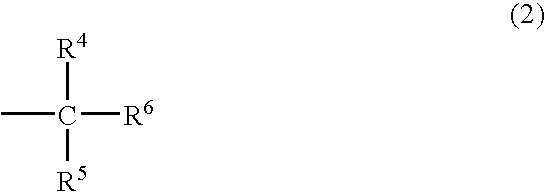Vinylphenylpropionic acid derivatives, production process therefor, polymer thereof and radiation sensitive resin composition
a technology of phenylpropionic acid and production process, applied in the field of lithography, can solve the problems of reducing the design rule of a semiconductor device, not being able to easily produce, and not being able to afford industrial production. cheap and safe,
- Summary
- Abstract
- Description
- Claims
- Application Information
AI Technical Summary
Benefits of technology
Problems solved by technology
Method used
Image
Examples
example 1
47 g (0.23 mol) of tri-n-butylphosphine and 90 ml of tetrahydrofuran (THF) were fed to a 1-liter three-necked flask and then 44.8 g (0.23 mol) of t-butyl bromoacetate was added dropwise to the solution under stirring at room temperature in a stream of nitrogen and stirred for 12 hours. Thereafter, the reactor was cooled with ice, 30 g (0.27 mol) of t-butoxy potassium dissolved in 100 ml of THF was added dropwise and stirred for 45 minutes, the reactor was returned to normal temperature, and 0.5 g of 2,4,6-tris(3',5'-di-t-butyl-4'-hydroxybenzyl) methylstyrene was added. After 40 g (0.26 mol) of p-chloromesitylene was added dropwise and stirred at 40.degree. C. for 12 hours, 140 g of a 10% aqueous solution of potassium carbonate was added and stirred at 40.degree. C. for 8 hours to carry out hydrolysis. THF contained in the reaction solution was distilled off under reduced pressure and the reaction product was extracted with n-hexane, washed with saturated brine and purified by silica...
example 2
(1) Synthesis of 4-vinylphenylpropionic Acid (Above Formula (5-1))
20 g (0.1 mol)of ethyl 4-vinylphenylpropionate was fed to a 1-liter three-necked flask, 100 ml of THF was added and well dissolved, and further 0.3 g of 2,4,6-tris(3',5'-di-t-butyl-4'-hydroxybenzyl)mesitylene was added. 100 ml of a 1.5 N aqueous solution of sodium hydroxide was added dropwise under stirring at room temperature and stirred at 50.degree. C. for 1.5 hours. After THF was distilled off under reduced pressure and the reaction product was extracted with 100 ml of n-hexane twice, 15 ml of 37% concentrated hydrochloric acid was added dropwise under stirring to produce a white precipitate. The precipitate was separated by filtration, washed in cold water completely and vacuum dried at 50.degree. C. for 12 hours to obtain 12 g of 4-vinylphenylpropionic acid (C.sub.11 H12O.sub.2). The yield was 68%. According to elemental analysis (wt %), C: 74.76 (calculated value: 74.98) and H: 6.91 (calculated value: 6.86). FI...
example 3
34 g of a compound represented by the following formula (ethyl 4-vinylphenylpropionate, molecular formula: C.sub.13 H.sub.16 O.sub.2) was obtained in the same manner as in Example 1 except that 38 g (0.23 mol) of ethyl bromoacetate was used. The yield was 73%. According to elemental analysis (wt %), C: 76.78 (calculated value: 76.44) and H: 7.84 (calculated value: 7.90). FIG. 7 shows a nuclear magnetic resonance spectrum of this compound and FIG. 8 shows an infrared absorption spectrum of this compound. ##STR29##
PUM
| Property | Measurement | Unit |
|---|---|---|
| Fraction | aaaaa | aaaaa |
| Fraction | aaaaa | aaaaa |
| Fraction | aaaaa | aaaaa |
Abstract
Description
Claims
Application Information
 Login to View More
Login to View More - R&D
- Intellectual Property
- Life Sciences
- Materials
- Tech Scout
- Unparalleled Data Quality
- Higher Quality Content
- 60% Fewer Hallucinations
Browse by: Latest US Patents, China's latest patents, Technical Efficacy Thesaurus, Application Domain, Technology Topic, Popular Technical Reports.
© 2025 PatSnap. All rights reserved.Legal|Privacy policy|Modern Slavery Act Transparency Statement|Sitemap|About US| Contact US: help@patsnap.com



